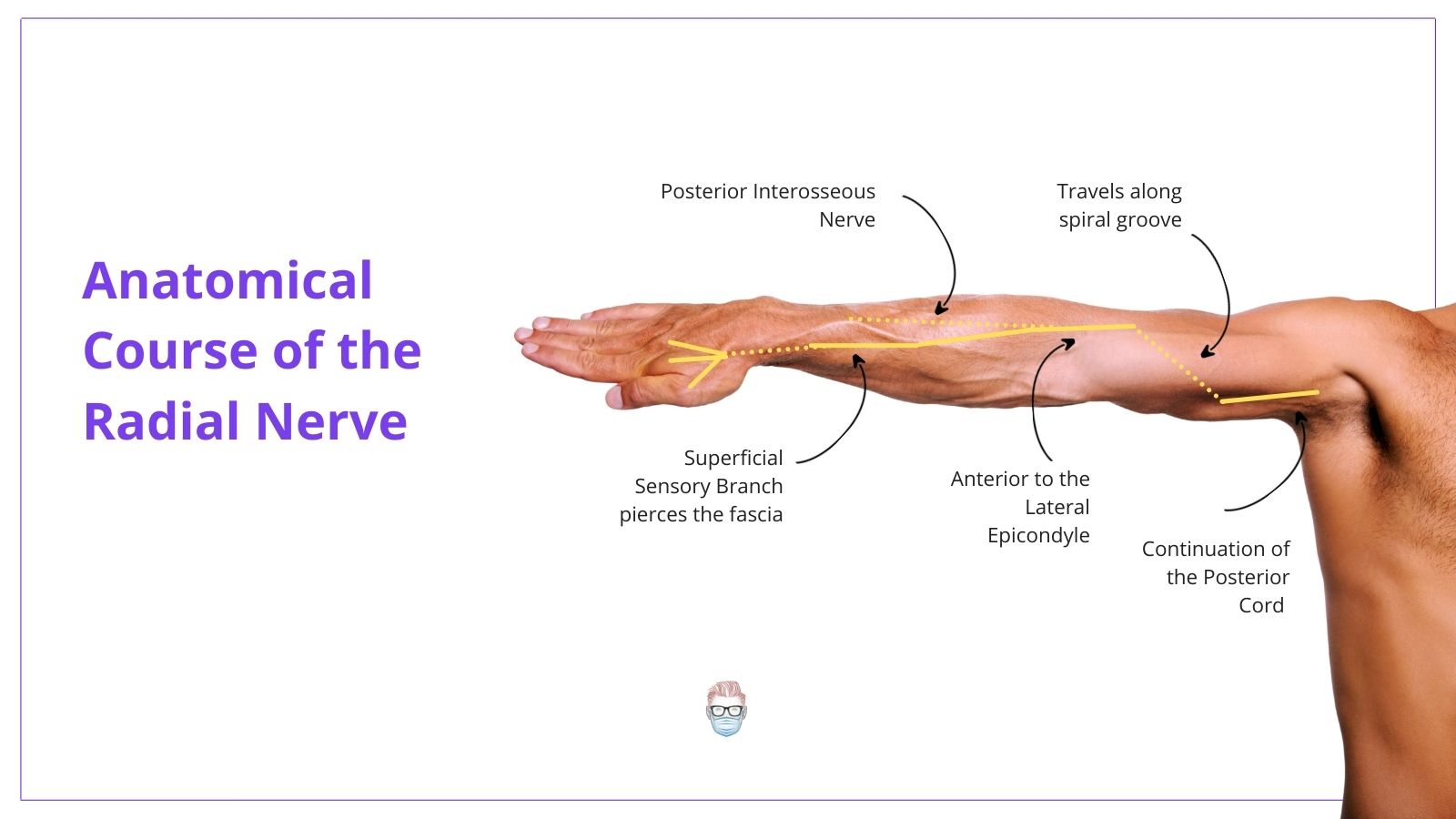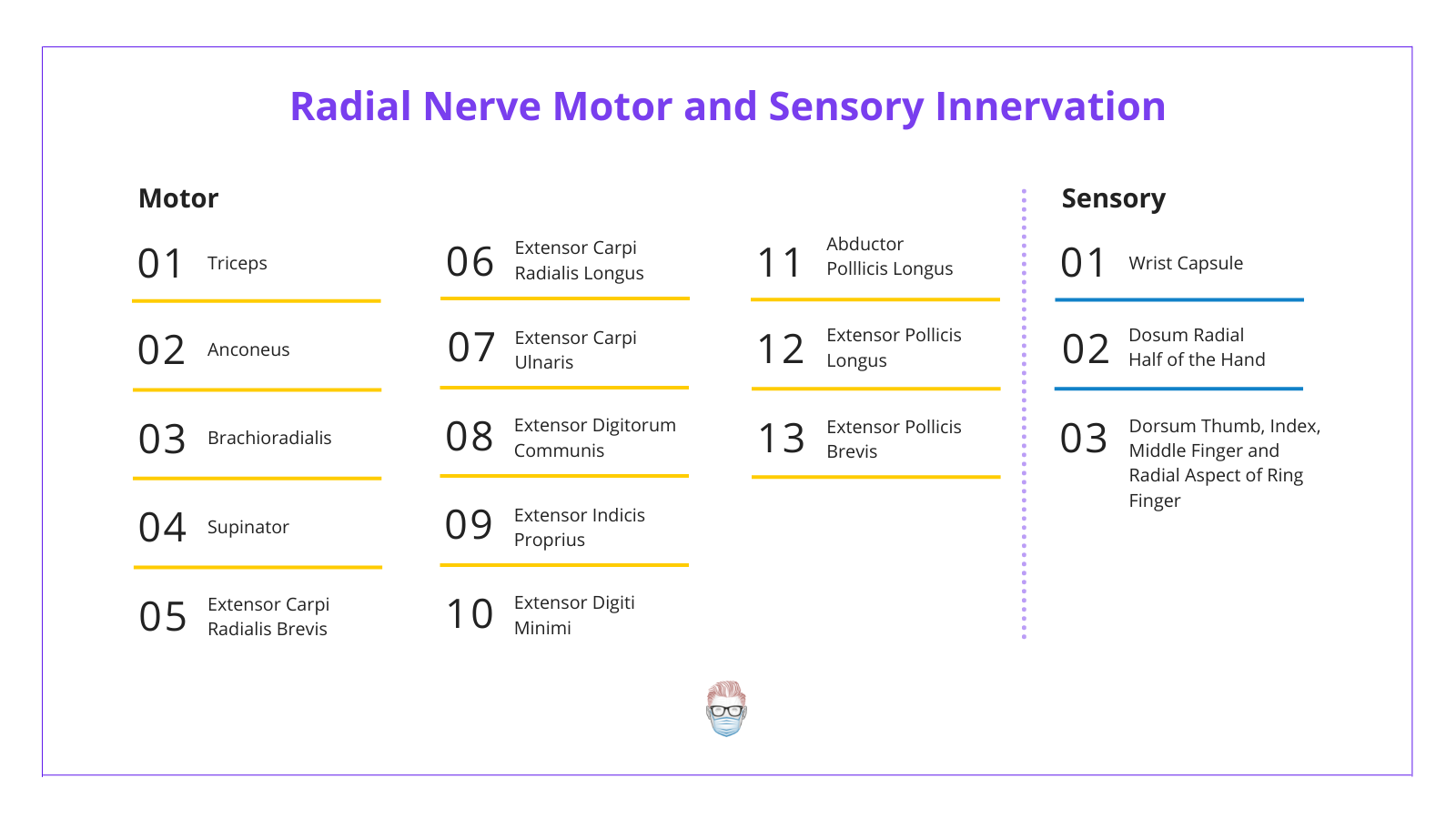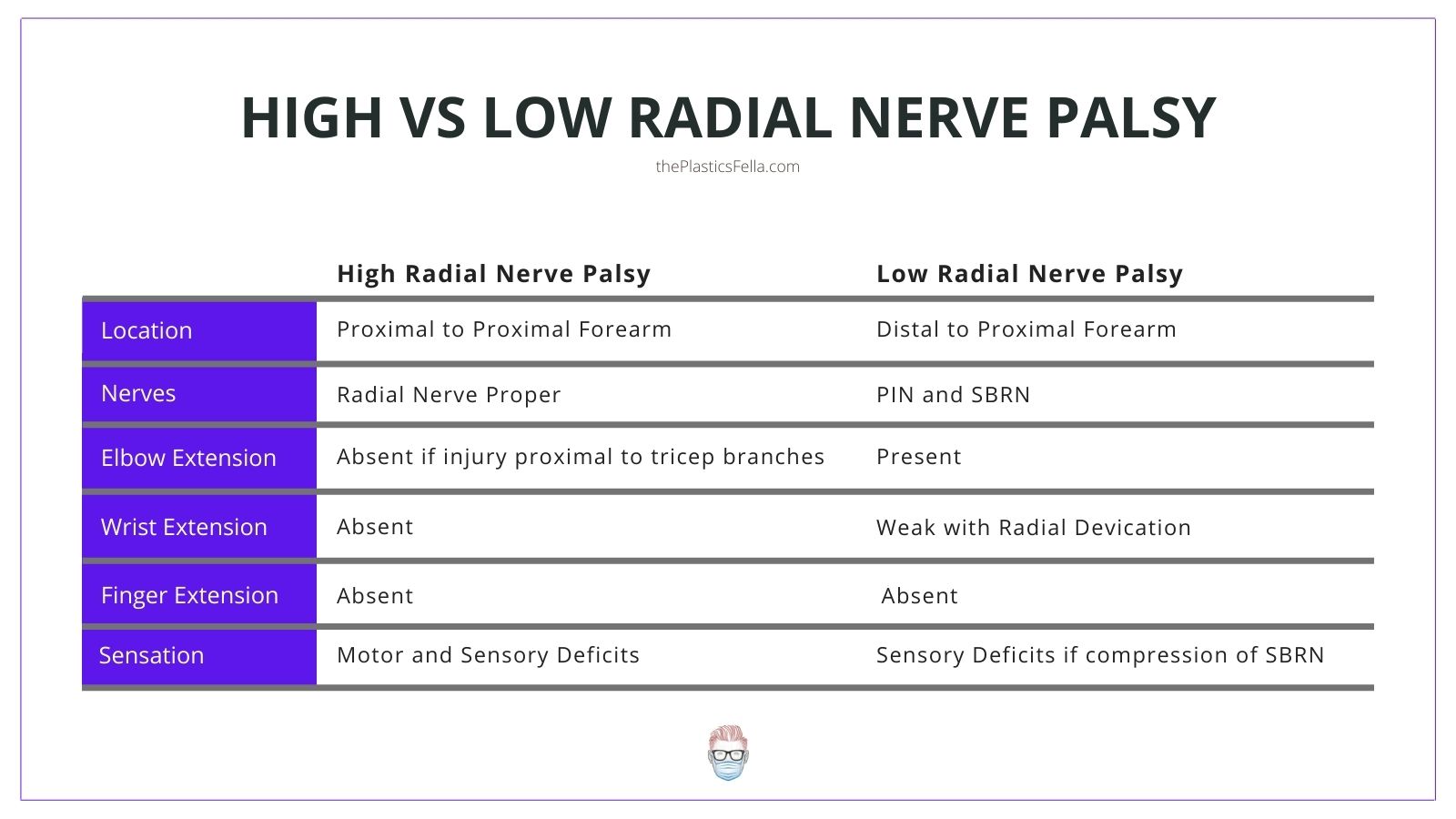Contributing Author: Dr Harsh Shah
Verified by thePlasticsFella
In this Article on Radial Nerve Palsy
5 Key Points on Radial Nerve Palsy
- The Radial Nerve arises from the posterior cord of the brachial plexus and terminates into the Posterior Interosseous (Motor) and Superficial Branch of Radial Nerve (Sensory)
- Radial Nerve Palsy results in loss of finger extension, wrist extension and elbow extension (in high radial nerve injuries)
- Investigations are dependent on the cause of the injury. Nerve Conduction Studies should be considered
- Management can be surveillance via splinting and physiotherapy, surgical decompression, nerve repair or tendon transfers. Each option is a case-by-case basis.
- Outcomes are dependent on the severity, type and timing of injury to the radial nerve.
Anatomy of Radial Nerve Palsy
Radial Nerve is the terminal branch of Brachial Plexus's Posterior Cord (C5-T1). The anatomical level of injury (high vs low) determines clinical presentation.
Arm (High)
A Radial Nerve injury at this level is classified as a "High Radial Nerve Palsy"
- Radial Nerve enters the arm through triangular space posterior to axillary artery and under the teres major muscle.
- It travels along the spiral groove in the posterior compartment close to the deep branch of brachial artery. It is found between the lateral and medial heads of the triceps.
- The nerve pierces the lateral intermuscular septum at the mid-humerus level to enter the anterior compartment. At this level it is deep to upper brachialis.

Elbow
- Radial nerve travels anterior to the level of the lateral epicondyle and traverses the antecubital fossa.
- The nerve terminates by dividing into two branches - a deep motor branch (PIN) and a superficial sensory branch (SBRN). This is when a radial nerve palsy becomes "low".
- The never gives off the PIN in the radial tunnel - as it passes between the two heads of the supinator it enters the extensor compartment of forearm.
Forearm
A radial nerve injury at this level is classified as a "Low Radial Nerve Palsy"
- Posterior Interosseous Nerve (PIN) arises in the radial tunnel. It enters the extensor compartment through the two heads of the supinator and travels between the deep and superficial flexor muscles bellies. This nerve is the motor supply to the extensor compartment.
- Superficial Branch of Radial Nerve (SBRN) travels deep to Brachioradialis (BR). It then emerges supra-fascially between BR and ECRL ~10 cm proximal to styloid process. This nerve then divides into terminal sensory branches ~5cm proximal to the radial styloid to provide sensory distribution to the dorsum hand.
- The lateral antebrachial cutaneous nerve has a significant overlap pattern with the radial sensory nerve
Hand
- Superficial Branch of Radial Nerve passess over the anatomical snuffbox.
- It enters the hand and terminalises into dorsal sensory cutaneous branches.
- It also innervates the APL muscle.
As the radial nerve travels along this pathway it provides motor and sensory innervation as detailed below.

High vs Low Radial Nerve Palsy
A low-palsy occurs distal to the elbow involves the posterior interosseous nerve. A high-palsy occurs proximal to the forearm and involves radial nerve proper. This results in different clinical presentations.

Low Radial Nerve Palsy
In a low radial nerve palsy, the injury occurs distal to the proximal forearm and involves the posterior interosseous nerve and/or superificial branch of the radial nerve. It can lead to a Posterior Interosseous Nerve Syndrome, Radial Tunnel Syndrome or Wartenburg Syndrome.
Clinical findings:
Unlike high radial nerve palsy, there is no loss of wrist extension. Radial nerve proper innervates brachioradialis, ECRL, ECRB before dividing into PIN and SBRN. This results in the following clinical presentation:
- Loss of finger
- Reduced thumb abduction (APB innervated by median nerve)
- Reduced wrist extension with radial deviation (ERCL, ERCB, BR not affected)
- No sensory disturbance
Common Causes include:
- Compression of the Posterior Interosseous Nerve at the Arcade of Froshe.
- Other anatomical sites of compression do exist and can be read here.
High Radial Nerve Palsy
In a high radial nerve palsy, the compression site is proximal to the proximal forearm and involves radial nerve proper. There are motor and sensory deficits and loss of wrist extension because the injury occurs before division into PIN and SBRN.
Clinical findings include:
- Findings of low radial nerve palsy AND
- Loss of wrist extension (loss of BR, ERCL and ERCB).
- Loss of elbow extension (triceps) if injury proximal to motor branches to triceps.
The commonest causes are:
- Prolonged pressure on the radial nerve in the spiral groove. This is commonly referred to as a "Saturday Night Palsy" after alcohol consumption.
- Humeral shaft fractures, whether primary due to the initial trauma, or secondary to their treatment.
Less common causes include:
- Compression of the radial nerve proximal to the elbow.
- Strenuous muscular activity causing compression at lateral head of triceps.
- A bony exostosis of the humerus.
Wartenberg Syndrome
Wartenberg Syndrome is the compression of the superifical branch of the radial nerve (SBRN). It was first descirbed in 1932 and results in a sensory disturbance without any motor deficit.
Key points include1,2:
- Paresthesia, pain, or numbness in the radial sensory nerve distribution
- Reproduced by forearm pronation and ulnar wrist flexion.
- Positive nerve percussion sign is identified over the radial sensory nerve at the point where it exits the deep fascia in the forearm.
- Differential diagnosis is de Quervian's Tenosynovitis.
Investigations in Radial Nerve Palsy
The purpose of investigations in radial nerve palsy is to identify the level of injury and for assessment of improvement with time/surgery.
Investigatons to consider, but are not limited to, are:
- MRI or Ultrasound if concern for entrapment.
- X-Ray if concern for fracture.
- Electrophyiological studies (EMG/NCS).
The brachioradialis (BR) can be used a guide for radial nerve recovery. It is the first muscle innervated by the radial nerve in the anterior compartment of the arm. Once function restored, it is likely that wrist and MCP joint extension will soon follow7
Management of Radial Nerve Palsy
The mangement of radial nerve palsy focuses on surveillance via splinting and physiotherapy, surgical decompression, nerve repair or tendon transfers. Each option is a case-by-case basis.
General Principles
A radial nerve injury can result in the loss of 3 major functions.
- Thumb extension
- Finger extension
- In high nerve palsies, wrist extension. This loss of active wrist extension results in an awkward flexed position that does not allow a powerful grip.
These need to be replaced, and should be done so through a multi-disciplinary approach of Surgeons, Occupational Therapists (for splinting) and Physiotherapist (for mobility). Unless a patient has a painful neuroma, the sensory part of the radial nerve usually can be ignored because loss of sensibility in its territory
Read more in-depth management options for Posterior Interosseous Nerve Palsy and Radial Tunnel Syndrome.
Conservative Management
Observation can be considered in the following patients with radial nerve palsy:
- Closed injuries with no other significant injuries
- Intact nerve but contused.
During this period of observation, consider:
- Dynamic Splinting via Outrigger Splint
- Passive mobilization of the upper limb joints distal to level of injury, to avoid joint stiffness
Traditional outrigger splints or newer lower-profile splints prevent the development of wrist and MCP joint contractures and can considerably enhance function7.
Surgical exploration & Decompression or repair
Open Exploration of the Radial Nerve is indicated in:
- Entrapped/Compression Radial Nerve
- Associated with fracture of bones
Nerve Repair options include:
- Primary nerve coaptation
- May require use of nerve graft (Sural nerve is the most common nerve graft cable used).
Tendon Transfers
Tendon Transfers for radial nerve palsies can be described in relating to timing and donor tendons.
In terms of timing, it can be early or delayed. Early transfers are performed within weeks of radial nerve injury to act as an internal splint. Usually consist of a single tendon transfer for wrist extension (allows power grip by positioning finger and thumb flexors at a biomechanical advantage). Delayed transfers are performed when nerve recovery is unlikely to happen. Timing for this surgery can rang from 6 months to 2 years. There is no general consensus on the "perfect" time to do a tendon transfer.
In terms of donor tendons, the classic transfers for radial nerve palsy include:
- Brand
- Jones: PT to provide active wrist extension10
- Modified Boyes
The preferred transfers for radial nerve palsy are the
- PT to ECRB
- PL to the rerouted EPL
- FCR to EDC.
An in-depth assessment on tendon transfers for radial nerve palsy is coming soon.
Considerations
Patient's often present on a spectrum of clinical presentations. Here are some other issues to consider during treatment of the radial nerve palsy:
- Distal nerve transfer to the target muscle procedure is indicated in cases wherein the level of injury jeopardizes the time duration required for the target hand muscles (small muscles) to receive impulses, considering the nerve growth rate.
- Delayed Presentation of Radial Nerve Palsy post-fracture reduction should be treated as a closed injury.
Outcomes
The expected outcome closely correlates with the severity of the injury.
- Neurapraxias recover ~3-4 weeks from injury, as remyelination occurs promptly.
- Axonotmesis injury involves Wallerian degeneration and a rate of nerve regrowth of 1 mm/day.
If expected prolonged recovery, delaying tendon transfers until that time seems reasonable to allow sufficient time for nerve recovery. During this time, a radial nerve splint will enhance function and should be prescribed.
Random Fact
The Radial Nerve innervates these muscles in the following order (this can be used a guide to find the location of the radial nerve injury)
- Brachioradialis
- ECRL
- Supinator
- ERCB
- EDC
- EDM
- APL
- EPL
- EPB
- EIP
References
- Mackinnon SE, Dellon AL, Hudson AR, et al: Chronic human nerve compression: a histological assessment. Neuropathol Appl Neurobiol 1986; 12: pp. 547-565
- Mackinnon SE, Dellon AL, Hudson AR, et al: Histopathology of chronic nerve compression of the superficial radial nerve in the forearm. J Hand Surg Am 1986; 11A: pp. 206-210
- G. Branovacki, M. Hanson, R. Cash, M. Gonzalez. The innervation pattern of the radial nerve at the elbow and in the forearm. J Hand Surg Br, 23 (1998), pp. 167-169.
- Bendersky, M., Bianchi, H.F. Double innervation of the brachialis muscle: anatomic–physiological study. Surg Radiol Anat 34, 865–870 (2012).
- Buchanan BK, Maini K, Varacallo M. Radial Nerve Entrapment. [Updated 2020 Jun 22]. In: StatPearls [Internet]. Treasure Island (FL): StatPearls Publishing; 2021 Jan-. Available from: https://www.ncbi.nlm.nih.gov/books/NBK431097/
- American Socity of Hand Surgery https://www.assh.org/hande/s/radial-nerve-and-tendon-transfers.
- Tsuge K. Tendon transfers for radial nerve palsy. Aust N Z J Surg. 1980 Jun;50(3):267-72.
- Chuinard RG, Boyes JH, Stark HH, Ashworth CR. Tendon transfers for radial nerve palsy: use of superficialis tendons for digital extension. J Hand Surg Am. 1978 Nov;3(6):560-70.
- Update on Tendon Transfers for Peripheral Nerve InjuriesRatner, Joshua A. et al.Journal of Hand Surgery, Volume 35, Issue 8, 1371 - 1381)
- Jones R: Ii. On suture of nerves, and alternative methods of treatment by transplantation of tendon. Br Med J 1916; 1: pp. 641-643.


